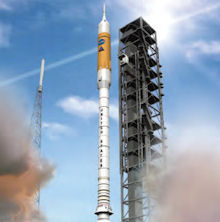To the aerospace industry in Southern California the proposed budget for NASA released this month is just that – a proposal. The document is still a work in progress with possible changes coming once Congress gets its say on the direction of the nation’s space program. As it stands now, the NASA budget comes in at $19 billion with an additional $6 billion to be added over another five years. More money would be put toward extending the use of the International Space Station and for the commercial space industry to build spacecraft that could be used by NASA. That’s the good news for groups such as the California Space Authority, a trade organization with the mission of growing the state’s space-related industries. The bad news is that the proposed budget eliminates funding for future manned space missions, namely the Constellation project that would return humans to the moon. That part of the budget causes concern for the CSA because of the impacts it will have on the contractors doing work on Constellation, which would use two versions of the Ares rocket – one for payloads only, the other for astronauts. “It still remains to be seen how this will work out,” said Janice Dunn, deputy director with the authority. According to a 2007 economic study on behalf of the CSA, California space enterprise brought in more than $30 billion in economic activity and employed some 371,000 people. Large-scale programs involving thousands of workers stretched coast to coast expanding the use of science and engineering have a history of going away and then being replaced by something else. When the Apollo space program ended in 1972, for instance, massive layoffs were not uncommon at the contractors and those left behind moved on to the Space Shuttle program. So the nixing of Constellation is just another example of that. At least, that is how Pratt & Whitney Rocketdyne with its headquarters and R& D facilities in Canoga Park sees the situation. A representative of the company declined to be interviewed but President Jim Maser said in a prepared statement that Pratt & Whitney will continue to work on contracted NASA programs as the budget moves through the approval process. As for the future, the company is ready to offer its experience, capability and talent towards developing safe commercial flight, Maser said. In 2007, Pratt & Whitney received a five-year, $1.2 billion contract for development and testing of the J-2X, the booster stage engine for the Ares rockets that is an updated version of the engines used on the Saturn V rockets during the Apollo era. The proposed NASA budget does include other projects that the J-2X engine could be used for. The decision by the Obama Administration to get rid of the Constellation program counters the recommendations of the Augustine Commission, an independent panel formed to study the future of the U.S. human spaceflight. In its final report released in October the commission found that going to the moon was a viable strategy and good preparation for the exploration of Mars. The commission’s recommendation for investment in technology for beyond low-earth orbit exploration was met favorably by the administration, which budgeted $7.8 billion over five years. The budget also includes $6 billion directed toward private industry, good news for the state’s fledgling commercial, or NewSpace, industry centered around the Mojave Air & Space Port in the desert 100 miles north of Los Angeles. Mojave is where Scaled Composites built and tested the spacecraft that won the X Prize and the Enterprise sub-orbital craft for Virgin Galactic. It is also home to XCOR Aerospace, whose founder Jeff Greason served on the Augustine Commission. While in the short term the proposed budget means little to XCOR in the long term the company can get in on NASA relying on commercial space industry to get its astronauts into space, said Dan DeLong, the chief engineer. Both NASA and the U.S. Air Force already use private contractors to launch satellites “The new twist is that mid term and long term, they will buy more services for manned vehicles,” DeLong said.
